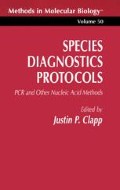Abstract
Species identification in microbiology has long been hampered by the limits of pure culture techniques. This is most evident in cases where morphologically conspicuous microorganisms have so far resisted all attempts of enrichment and cultivation like for many of the numerous endosymbionts of protozoa. Examples are the endonuclear symbionts in ciliates that have been known for more than a century (1). Cells of the genus Holospora multiply in the macro- or micronucleus of Paramecium caudatum. The characteristically elongated (infective) cell forms occurring during the developmental cycle are easily visualized by light microscopy. Also certain anaerobic ciliates live in close association with a variety of endo- and ectosymbionts (2), many of which were presumably classified as methanogens by the characteristic blue fluorescence of the coenzyme F420 (3). This list could be considerably enlarged reflecting the common strategy of the unicellular protozoa to subsidize certain tasks to endosymbiotic microorganisms.
Access this chapter
Tax calculation will be finalised at checkout
Purchases are for personal use only
References
Görtz, H.-D. (1986) Endonucleobiosis in ciliates. Int. Rev. Cytol. 102, 169–213.
Fenchel, T., Perry, T., and Thane, A. (1977) Anaerobrosis and symbiosis with bacteria of free-living ciliates. J. Protozool. 24, 154–163.
Van Bruggen, J. J. A., Stumm, C. K., and Vogels, G. D. (1983) Symbiosis of methanogenic bacteria and sapropelic protozoa. Arch. Mikrobiol. 136, 89–95.
Woese, C. R. (1987) Bacterial evolution. Microbiol. Rev.. 51,221–271.
Ward, D. M., Weller, R., and Bateson, M. M. (1990) 16S rRNA sequences reveal numerous uncultured microorganisms in a natural community. Nature 345,63–65.
Giovannoni, S. J., Britschgi, T. B., Moyer, C. L., and Field, K. G. (1990) Genetic diversity in Sargasso Sea bacterioplankton. Nature 345,60–63.
Schmidt, T. M., DeLong, E. F., and Pace, N. R. (1991) Analysts of a marine picoplankton community by 16S rRNA gene cloning and sequencing J. Bacteriol. 173,4371–43
DeLong, E. F., Wickham, G. S., and Pace, N. R. (1989) Phylogenetic stains ribosomal RNA-based probes for the identification of single microbial cells. Science 243, 1360–13
Amann, R., Springer, N., Ludwig, W., Görtz, H.-D., and Schleifer, K.-H (1991) Identification in situ and phylogeny of uncultured bacterial endosymbionts. Nature 351, 161–164.
Springer, N., Ludwig, W., Amann, R., Schmidt, H. J., Gortz, H.-D., and Schleifer, K.-H. (1993) Occurrence of fragmented 16S rRNA in an obligate bacterial endosymbiont of Paramecium caudatum. Proc. Natl. Acad. Sci. USA 90, 9892–9895.
Embley, T. M., Finlay, B. J., and Brown, S. (1992) RNA sequence analysis shows that the symbionts in the ciliate Metopus contortus are polymorphs of a single methanogen species. FEMS Microbiol. Lett. 97, 57–62.
Embley, T. M., Finlay, B. J., Thomas, R. H., and Dyal, P. L. (1992) The use of rRNA sequences and fluorescent probes to investigate the phylogenetic positions of the anaerobic ciliate Metopus palaeformis and its archaeobacterial endosymbiont. J. Gen. Microbiol. 138, 1479–1487.
Finlay, B. J., Embley, T. M., and Fenchel, T. (1993) A new polymorphic methanogen, closely related to Methanocorpusculumparvum, living in stable symbiosis within the anaerobic ciliate Trimyema sp.. J. Gen. Microbiol. 139, 371–378.
Springer, N., Ludwig, W., Drozanski, V., Amann, R., and Schlerfer, K.-H. (1992) The phylogenetic status of Sarcobium Zyticum, an obligate intracellular bacterial parasite of small amoebae. FEMS Microbiol. Lett. 96, 199–202.
Heckmann, K. and Schmidt, H. J. (1987) Polynucleobacter necessanus gen. nov., sp. nov., an obligately endosymbiotic bacterium living in the cytoplasm of Euplotes aediculatus. Int. J. System. Bacteriol.. 37, 456,457.
Springer, N. (1992) Phylogenie und in-situ Nachweis nicht-kultivierbarer bakterieller Endosymbionten PhD. thesis, Technische Universitat Munchen, Germany.
Johnson, M. T., Read, B. A., Manko, A. M., Pappas, G., and Johnson, B. A. (1986) A convenient new method for desalting, deprotemizing, and concentrating DNA and RNA. Biotechniques 4,64–70.
Stahl, D. A. and Amann, R. (1991) Development and application of nucleic acid probes in bacterial systematics, in Sequencing and Hybridization Techniques in Bacterial Systematics (Stackebrandt, E. and Goodfellow, M., eds.), Wiley, Chichester, UK, pp. 205–248.
Manz, W., Amann, R., Ludwig, W., Wagner, M., and Schleifer, K.-H. (1992) Phylogenetic oligodeoxynucleotide probes for the major subclasses of proteobacteria problems and solutions. System Appl. Microbiol. 15, 593–600.
Devereux, R., Kane, M. D., Winfrey, J., and Stahl, D. A. (1992) Genus-and group-specific hybridization probes for determinative and environmental studies of sulfate-reducing bacteria. Syst. Appl. Microbiol. 15, 601–609.
Haase, A., Brahic, M., Stowring, L., and Blum, H. (1984) Detection of viral nucleic acids by in situ hybridization, in Methods in virology, vol. 7 (Hamorosch, K. and Koprowski, H., eds.), Academic, New York, pp. 189–226.
Stahl, D. A., Flesher, B., Mansfield, H. R., and Montgomery, L. (1988) Use of phylogenetically based hybridization probes for studies of ruminal microbial ecology. Appl. Environ. Microbiol. 54, 1079–1084.
Stahl, D. A, Devereux, R., Amann, R. I., Flesher, B., Lin, C., and Stromley, J. (1989) Ribosomal RNA based studies of natural microbial diversity and ecology, in Recent Advances in Microbial Ecology (Hattori, T., Ishida, Y., Maruyama, Y., Morita, R, and Uchida, A., eds.), Japan Scientific Societies Press, Tokyo, Japan, pp. 669–673.
Zarda, B., Amann, R., Wallner, G., and Schleifer, K. H. (1991) Identification of single bacterial cells using digoxigenin-labelled, rRNA-targeted oligonucleotides. J. Gen. Microbiol. 137, 2823–2830.
Amann, R., Zarda, B., Stahl, D. A., and Schleifer, K.-H. (1992) Identification of individual prokatyotic cells by using enzyme-labeled, rRNA-targeted oligonucleotide probes. Appl. Environ. Microbiol. 58, 3007–3011.
Trebesius, K., Amann, R., Ludwig, W., Mühlegger, K., and Schleifer, K. H. (1994) Identification of whole fixed bacterial cells with nonradioactive rRNA-targeted transcript probes. Appl. Environ. Microbiol. 60,3228–3235.
Author information
Authors and Affiliations
Editor information
Editors and Affiliations
Rights and permissions
Copyright information
© 1996 Humana Press Inc.
About this protocol
Cite this protocol
Springer, N., Amann, R., Ludwig, W. (1996). The Design and Application of Ribosomal RNA-Targeted, Fluorescent Oligonucleotide Probes for the Identification of Endosymbionts in Protozoa. In: Clapp, J.P. (eds) Species Diagnostics Protocols. Methods in Molecular Biology™, vol 50. Humana Press. https://doi.org/10.1385/0-89603-323-6:133
Download citation
DOI: https://doi.org/10.1385/0-89603-323-6:133
Publisher Name: Humana Press
Print ISBN: 978-0-89603-323-8
Online ISBN: 978-1-59259-537-2
eBook Packages: Springer Protocols

